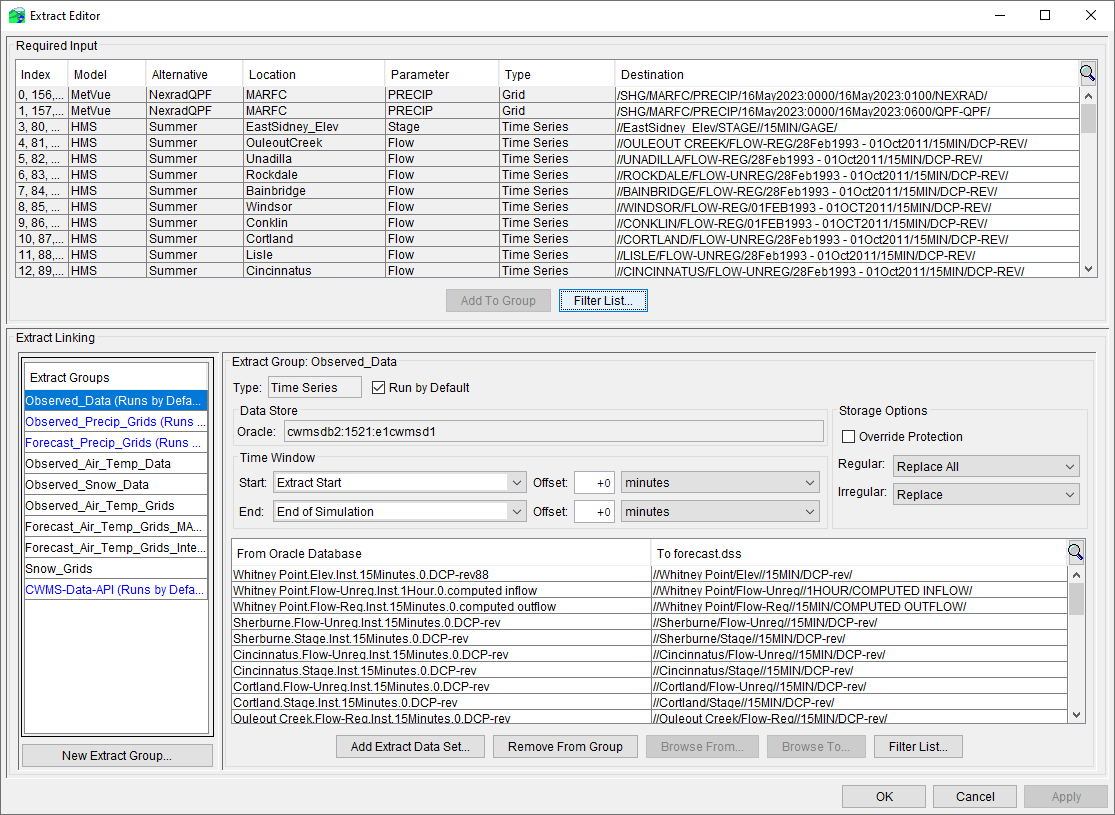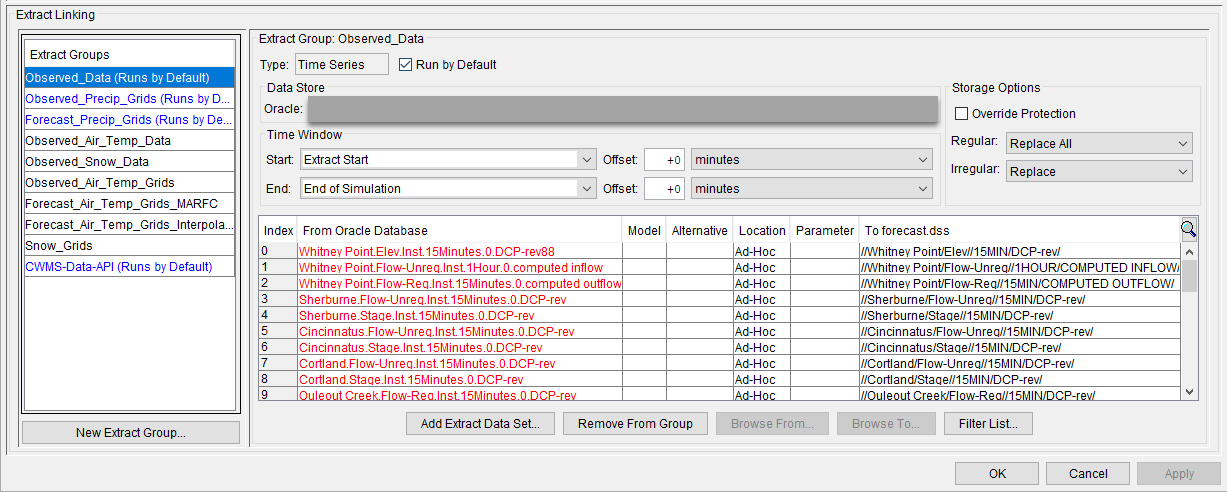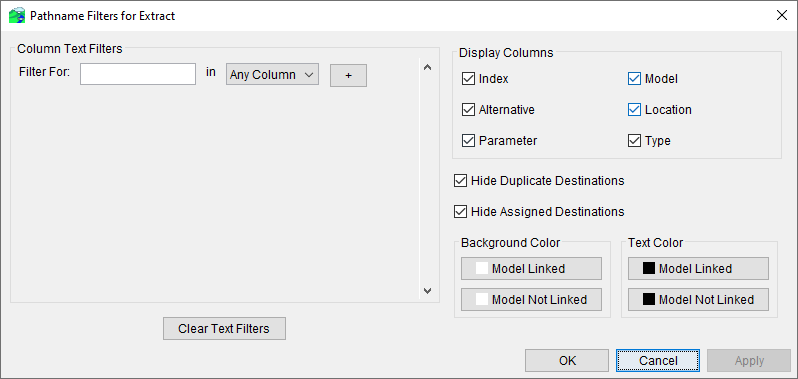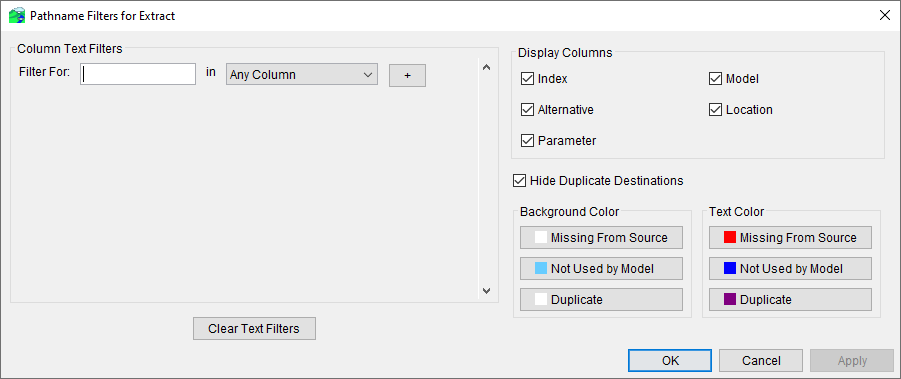Download PDF
Download page Extract Editor.
Extract Editor
After you have completed the model linking using the Model Linking, you will need to configure extracts that are required by model alternatives. Configuring an extract is completed using the Extract Editor, which allows you to connect required model alternative input data from multiple sources to the forecast.dss file that provides input data to model alternatives during the compute process. The required input data is classified into extract groups that link the source data information to the required input records.
You access the Extract Editor from the Setup module. Select Edit Extract from the Models menu, andtThe Extract Editor dialog will open.

The Extract Editor is comprised of two sections: Required Input and Extract Linking. The Required Input section contains a table that lists the required input records for each model alternatives. The Extract Linking section contains information on defined extract groups, and contains a table which lists the input records and source records assigned to an extract group.
Required Input Section
The Required Input section provides a list of the time series that need source records to provide input data for the forecast compute.

The Required Input section provides information on the following:
- Index - a number assigned to each required destination pathname (the number has no real usage except in keeping the initial filtered list set), and each pathname can have multiple indices
- Model - the name of the software application requesting the required input record
- Alternative - the name of the model alternative requesting the required input record
- Location - the name of the model location that is associated with the input record
- Parameter - the parameter associated with the input record (flow, stage, etc.)
- Type - the type of data required (either time series data or gridded data)
- Destination - the actual input record pathname that the models require (the pathname that will be written to the forecast.dss file, used by models during the compute)
This information does not display by default in the Required Input table. You will need to set up the table view - see the Table View Options section below for more information.
Extract Linking Section
The Extract Linking section displays information on the extract groups. Extract groups link similar types of data (gridded or time series) to a single data source. The source can be an HEC-DSS file, a CWMS database, or a WISKI database (WISKI Extract and Post). The source records will be mapped to the required input records in the extract group. During the creation of a forecast, the source records will be copied into the required input pathnames which are created in the forecast.dss file.

The Extract Linking section provides information on the following:
- Index - a number assigned to each required destination pathname (the number has no real usage except in keeping the initial filtered list set), and each pathname can have multiple indices
- From <data source> - the source pathname that will fill the HEC-DSS record displayed in the To forecast.dss column
- Model - the software application requesting the required input record
- Alternative - the model alternative that is requesting the input record
- Location - the location that is associated with the input record
- Parameter - the parameter associated with the input record's data
- To forecast.dss - the input record pathname that the model requires (the pathname that will be written to the forecast.dss file and used by the model during the compute)
This information does not display by default in the Extract Linking table. You will need to set up the table view - see the Table View Options section below for more information.
Table View Options
You can change the types of information displayed in the tables in both the Required Input and the Extract Linking sections. You can access the Pathname Filters for Extract dialog by either clicking on the magnifying glass icon in the top right corner of the table or by clicking on the Filter List button below the table you want to filter.

From the Column Text Filters box you can filter the records to display only records that contain a certain phrase or string of text. Filtering can be done by Column, Index, Model, Alternative, Location, Parameter, Type, or Destination. You can filter for multiple requirements by clicking +. Below are examples of several different ways that you can filter:
- Filters can be used to retrieve only records that are an exact match. You can do this by typing a string of text in the Filter For: box.
- Filters can be used to retrieve records that start, end, or contain a specific string. To do this, use an asterisk (*) after, before, or inserted into the string of text you want to filter for.
From the Display Columns box you can select which columns in the table to view.
You can condense records that have the same destination to one row by selecting Hide Duplicate Destinations. To no longer view input record pathnames that have already been assigned to an extract group, select Hide Assigned Destinations. The Hide Assigned Destinations option is not available for the Extract Linking section.
You can also color code the destination records listed in the Required Input section depending on if the destination record is linked to a source record. You can color code by background or text.
You can also color code the records listed in the Extract Linking section depending on if the destination record is missing from a source, not used by a model, or is a duplication. You can color code by background or text.
